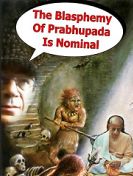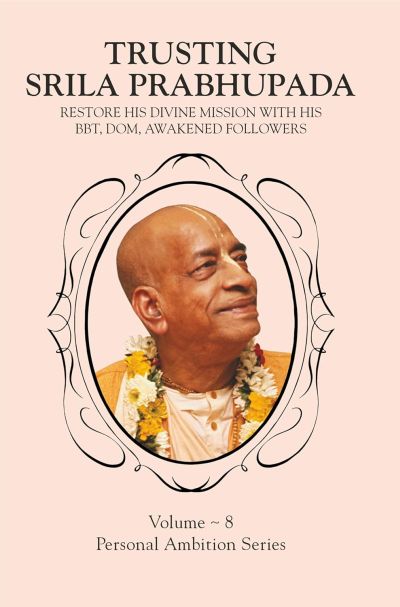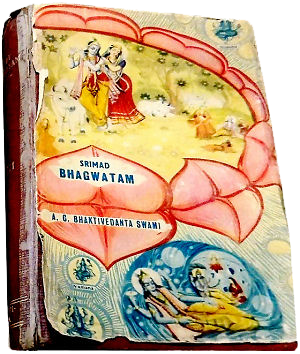Lord Kṛṣṇa is Charmed by His Own Reflection
and wants to embrace Himself
Kṛṣṇa’s lustre of sweet youthfulness is so extraordinary beautiful that even He Himself is charmed by this unique brilliance. By seeing his own reflection, he gets attracted to it, thus he desires to take the form of Śrī Rādhā, since Rādhā is able to see his form in front of her.
How Kṛṣṇa is attracted by His own beauty is described in Lalita-mādhava (8.34):
Upon seeing His own picture, Kṛṣṇa lamented, “How glorious this picture is! It is attracting Me just as it attracts Rādhārāṇī.”
Kṛṣṇa is so wonderful and attractive that He Himself becomes attracted by His own beauty, and this is proof that He is full of all inconceivable potencies. As far as the ornaments decorating Kṛṣṇa’s body are concerned, it appears that they do not beautify Him but that they themselves become beautiful simply by being on His body. Always standing in a three-curved way, He attracts all living entities, including the demigods. Indeed, He even attracts the Nārāyaṇa form who presides in every Vaikuṇṭha planet. (Teachings of Lord Caitanya)
āpana-mādhurye hare āpanāra mana
āpanā āpani cāhe karite āliṅgana
“Lord Kṛṣṇa’s sweetness is so attractive that it steals away His own mind. Thus He even wants to embrace Himself.” (CC Madhya 8.148)
aparikalita-pūrvaḥ kaś camatkāra-kārī
sphurati mama garīyān eṣa mādhurya-pūraḥ
ayam aham api hanta prekṣya yaṁ lubdha-cetāḥ
sa-rabhasam upabhoktuṁ kāmaye rādhikeva
“Upon seeing His own reflection in a bejeweled pillar of His Dvārakā palace, Kṛṣṇa desired to embrace it, saying, “Alas, I have never seen such a person before. Who is He? Just by seeing Him I have become eager to embrace Him, exactly like Śrīmatī Rādhārāṇī.” (CC Madhya 8.149)
Kṛṣṇa is so beautiful, transcendental and attractive that He sometimes attracts even Himself. The following verse appears in Gīta-govinda (1.11):
viśveṣām anurañjanena janayann ānandam indīvara-
śreṇī-śyāmala-komalair upanayann aṅgair anaṅgotsavam
svacchandaṁ vraja-sundarībhir abhitaḥ pratyaṅgam āliṅgitaḥ
śṛṅgāraḥ sakhi mūrtimān iva madhau mugdho hariḥ krīḍati
“My dear friend, just see how Kṛṣṇa is enjoying His transcendental pastimes in the spring by expanding the beauty of His personal body. His soft legs and hands, just like the most beautiful moon, are used on the bodies of the gopīs. When He embraces different parts of their bodies, He is so beautiful. Kṛṣṇa is so beautiful that He attracts even Nārāyaṇa, as well as the goddess of fortune who associates with Nārāyaṇa.”
(from: Teachings of Lord Chaitanya)
In Śrīmad-Bhāgavatam (10.89.58) the Bhūmā-puruṣa (Mahā-Viṣṇu) told Kṛṣṇa, “My dear Kṛṣṇa and Arjuna, I have taken the brāhmaṇa’s sons just to see You.” Arjuna attempted to save some youths who had died untimely at Dvārakā, and when he failed to save them, Kṛṣṇa took him to the Bhūmā-puruṣa, and when the Bhūmā-puruṣa brought forth those dead bodies as living entities, He said, “Both of you appear to preserve religious principles in the world and to annihilate the demons.” In other words, the Bhūmā-puruṣa was also attracted by the beauty of Kṛṣṇa, and He concocted this pastime just as a pretext to see Kṛṣṇa. It is recorded in Śrīmad-Bhāgavatam (10.16.36) that after the serpent Kāliya was punished by Kṛṣṇa, one of Kāliya’s wives told Kṛṣṇa, “Dear Lord, we cannot understand how this fallen serpent got the opportunity of being kicked by Your lotus feet when even the goddess of fortune underwent austerities for several years just to see You.”(from: Teachings of Lord Chaitanya)
Since one of His opulences is infinite beauty, all the Lord’s incarnations are very beautiful and are appreciated as such by devotees. (SB 5.18.29 p)
Lord Kṛṣṇa’s beauty is unequaled and unsurpassed. (CC Madhya 9.144)
The Lord is the transcendental form of eternity, cognition and beauty. (SB 1.5.20 p)
The bodily beauty of Śrī Kṛṣṇa is like a wave in the ocean of eternal youth. (CC Madhya 21.113)
Although Kṛṣṇa’s unparalleled beauty is the topmost sweetness of love of Godhead, His sweetness increases unlimitedly when He is in the company of the gopīs. Consequently Kṛṣṇa’s exchange of love with the gopīs is the topmost perfection of love of Godhead. (CC Madha 8.94)
The beauty of the Lord was so enchanting that it could not be sufficiently described. The goddess of fortune is supposed to be the most beautiful sight within the spiritual and material creations of the Lord; she has a sense of being the most beautiful, yet her beauty was defeated when the Lord appeared. In other words, the beauty of the goddess of fortune is secondary in the presence of the Lord. In the words of Vaiṣṇava poets, it is said that the Lord’s beauty is so enchanting that it defeats hundreds of thousands of Cupids. He is therefore called Madana-mohana. It is also described that the Lord sometimes becomes mad after the beauty of Rādhārāṇī. Poets describe that under those circumstances, although Lord Kṛṣṇa is Madana-mohana, He becomes Madana-dāha, or enchanted by the beauty of Rādhārāṇī. Actually the Lord’s beauty is superexcellent, surpassing even the beauty of Lakṣmī in Vaikuṇṭha. The devotees of the Lord in the Vaikuṇṭha planets want to see the Lord as the most beautiful, but the devotees in Gokula or Kṛṣṇaloka want to see Rādhārāṇī as more beautiful than Kṛṣṇa. (SB 3.15.42)
Śrī Brahma-saṁhitā
TEXT 5.30
veṇuṁ kvaṇantam aravinda-dalāyatākṣam-
barhāvataṁsam asitāmbuda-sundarāṅgam
kandarpa-koṭi-kamanīya-viśeṣa-śobhaṁ
govindam ādi-puruṣaṁ tam ahaṁ bhajāmi
I worship Govinda, the primeval Lord, who is adept in playing on His flute,
with blooming eyes like lotus petals, with head decked with peacock’s feather,
with the figure of beauty tinged with the hue of blue clouds,
and His unique loveliness charming millions of Cupids.
This beauty of the Supreme Lord can be seen by devotees who are in love with Him, devotees whose eyes are anointed with love of Godhead [premāñjana-cchurita-bhakti-vilocanena] (SB 5.3.2, Purport)
The matchless beauty of Kṛṣṇa, the Supreme Lord of Goloka, is being described. Kṛṣṇa, the all-pervading cognition, has a spiritual form of His own. The form of Kṛṣṇa is not a fanciful creation of imagination formed after visualizing the beautiful things of the world. What Brahmā saw in his ecstatic trance of pure devotion, is being described.
Kṛṣṇa is engaged in playing upon His flute. That flute by his enchanting musical sound attracts the hearts of all living beings. Just as a lotus petal produces a pleasant sight, so the two beautiful eyes of Kṛṣṇa who causes the manifestation of our spiritual vision, display the unlimited splendor and beauty of His moonlike face. The loveliness that adorns His head with peacock feather figures, the corresponding feature of the spiritual beauty of Kṛṣṇa. Just as a mass of blue clouds offers a specifically soothing, pleasant view, the complexion of Kṛṣṇa is analogously tinged with a spiritual dark-blue color. The beauty and loveliness of Kṛṣṇa is far more enchanting that that of Cupid multiplied a millionfold.
“I worship Govinda, the primeval Lord, round whose neck is swinging a garland of flowers beautified with the moon-locket, whose two hands are adorned with the flute and jeweled ornaments, who always revels in pastimes of love, whose graceful threefold-bending form of Śyāmasundara is eternally manifest..”

The Lord’s beauty resembles a dark cloud during the rainy season. As the rainfall glistens, His bodily features also glisten. Indeed, He is the sum total of all beauty. The Lord has four arms and an exquisitely beautiful face with eyes like lotus petals, a beautiful highly raised nose, a mind-attracting smile, a beautiful forehead and equally beautiful and fully decorated ears. (SB 4.24.45-46)
After the scorching heat of the summer season, it is very pleasing to see dark clouds in the sky. As confirmed in Brahma-saṁhitā: barhāvataṁsam asitāmbuda-sundarāṅgam. The Lord wears a peacock feather in His hair, and His bodily complexion is just like a blackish cloud. The word sundara, or snigdha, means “very pleasing.” Kandarpa-koṭi-kamanīya. Kṛṣṇa’s beauty is so pleasing that not even millions upon millions of Cupids can compare to it.
The Lord’s beauty is compared to rainfall because when the rain falls in the rainy season, it becomes more and more pleasing to the people. After the scorching heat of the summer season, the people enjoy the rainy season very much. Indeed, they even come out of their doors in the villages and enjoy the rainfall directly. Thus the Lord’s bodily features are compared to the clouds of the rainy season. The devotees enjoy the Lord’s beauty because it is a collection of all kinds of beauties. Therefore the word sarva-saundarya-saṅgraham is used. No one can say that the body of the Lord is wanting in beautiful parts. It is completely pūrṇam. Everything is complete: God’s creation, God’s beauty and God’s bodily features. All these are so complete that all one’s desires can become fully satisfied when one sees the beauty of the Lord. The word sarva-saundarya indicates that there are different types of beauties in the material and spiritual worlds and that the Lord contains all of them. Both materialists and spiritualists can enjoy the beauty of the Lord. Because the Supreme Lord attracts everyone, including demons and devotees, materialists and spiritualists, He is called Kṛṣṇa. (SB 4.24.45-46)
Don’t think that Kṛṣṇa figure is the imagination of some artist or painter. No, no. These are the description in the Vedas. Veṇuṁ kvaṇantam, the Supreme Personality of Godhead, Govinda, is playing on His flute. Veṇuṁ kvaṇantam aravinda-dalāyatākṣam. And His eyes are like the petals of lotus flower. Veṇuṁ kvaṇantam aravinda-dalāyatākṣaṁ barhāvataṁsam. There is a feather of peacock, asitāmbuda-sundarāṅgam, His complexion is like black cloud but very, very beautiful. Veṇuṁ kvaṇantam aravinda-dalāyatākṣaṁ barhāvataṁsam asitāmbuda-sundarāṅgam, kandarpa-koṭi-kamanīya. He is so beautiful that more attractive than many, many hundreds and thousands of Cupid. Kandarpa-koṭi-kamanīya-viśeṣa-śobhaṁ govindam ādi-puruṣaṁ tam aham bhajāmi. This is the Govinda’s description. There are so many descriptions. (Lecture on SB 3.25.29 — Bombay, November 29, 1974)
As confirmed in the Brahma-saṁhitā (5.30), barhāvataṁsam asitāmbuda-sundarāṅgam: the hue of the Lord’s beautiful form resembles the blackish color of dense clouds (asita means “blackish,” and ambuda means “cloud”). Yes, Kṛṣṇa is black, but at the same time all-attractive. So many beautiful gopīs all became attracted. So many queens all became attracted. So this blackness of Kṛṣṇa is not this ordinary. Therefore in the Brahma-saṁhitā it is said that kandarpa-koṭi-kamanīya-viśeṣa-śobham. Kṛṣṇa’s blackness is not ordinary blackness. Asitāmbuda-sundarāṅgam. Although He’s blackish like the black cloud, but sundara, very, very beautiful. How much beautiful? Kandarpa-koṭi-kamanīya-viśeṣa-śobham. He’s so beautiful that if you bring millions and millions of Cupids… Cupid is supposed to be very beautiful. Still, He will surpass. So Kṛṣṇa… Śyāmasundaram. Śyāma means black, and still, very, very beautiful. That is the understanding of Kṛṣṇa.
Text 5.38
premāñjana-cchurita-bhakti-vilocanena
santaḥ sadaiva hṛdayeṣu vilokayanti
yaṁ śyāmasundaram acintya-guṇa-svarūpaṁ
govindam ādi-puruṣaṁ tam ahaṁ bhajāmi
I worship Govinda, the primeval Lord, who is Śyāmasundara, Kṛṣṇa Himself with innumerable inconceivable attributes, whom the pure devotees see in their heart of hearts with the eye of devotion tinged with the salve of love.
“Those who are in ecstasy of love with the Supreme Personality of Godhead, Lord Śyāmasundara (Kṛṣṇa), see Him always in their hearts due to love and devotional service rendered to the Lord.” Both Vidura and Uddhava were such elevated devotees, and therefore they both came to the bank of the Yamunā and met each other.
Krsna Book 35:
Another gopī said, “My dear friends, Kṛṣṇa is so beautiful that the goddess of fortune always remains on His chest, and He is always adorned with a golden necklace. Beautiful Kṛṣṇa plays His flute in order to enliven the hearts of many devotees.
Krsna Book 38:
Today I shall be able to see the Supreme Personality of Godhead, who by His transcendental beauty has attracted the goddess of fortune to live with Him perpetually. As soon as I arrive in Vṛndāvana, I will get down from this chariot and fall prostrate to offer my obeisances to the Supreme Lord, the master of material nature and all living entities.
My dear friends, Krishna is so beautiful that the goddess of fortune always remains on His chest and He is always adorned with a golden necklace. Beautiful Krishna plays His flute in order to enliven the hearts of many devotees. He is the only friend of the suffering living entities. When He plays His flute, all the cows and other animals of Vrindavana, although engaged in eating, simply take a morsel of food in their mouths and stop chewing. Their ears raise up and they become stunned. They do not appear alive but like painted animals. Krishna’s flute-playing is so attractive that even the animals become enchanted, and what to speak of ourselves.
All of these features combine to make Krishna’s beauty fully satisfying. While material beauty offers momentary pleasure to the senses. Krishna’s spiritual beauty touches the very soul of the living being thrilling him with a pleasure so wonderful that once having relished it he can never give it up. Srila Rupa Gosvami has therefore advised,
My dear friend, if you still have any desire to enjoy the company of your friends within this material world, then don’t look upon the form of Krishna, who is standing on the bank of Keshi-ghata. He is known as Govinda, and His eyes are very enchanting. He is playing upon His flute, and on His head there is a peacock feather. His whole body is illuminated by the moonlight in the sky.
In the words of Vaiṣṇava poets, it is said that the Lord’s beauty is so enchanting that it defeats hundreds of thousands of Cupids. He is therefore called Madana-mohana. It is also described that the Lord sometimes becomes mad after the beauty of Rādhārāṇī. Poets describe that under those circumstances, although Lord Kṛṣṇa is Madana-mohana, He becomes Madana-dāha, or enchanted by the beauty of Rādhārāṇī. Actually the Lord’s beauty is superexcellent, surpassing even the beauty of Lakṣmī in Vaikuṇṭha.
The Beauty of Kṛṣṇa
Teachings of Lord Caitanya 10
Kṛṣṇa is known as Madana-mohana because He conquers the mind of Cupid. He is also known as Madana-mohana due to His accepting the devotional service of the damsels of Vraja and rendering favors unto them. After conquering Cupid’s pride, the Lord engages in the rāsa dance as the new Cupid. He is also known as Madana-mohana because of His ability to conquer the minds of women with His five arrows called form, taste, smell, sound and touch. The pearls of the necklace which hangs about the neck of Kṛṣṇa are as white as ducks, and the peacock feather which decorates His head is colored like a rainbow. His yellow garment is like lightning in the sky, and Kṛṣṇa Himself is like the newly arrived clouds. The gopīs are like footbells on His feet, and when the cloud pours rain on the grains in the field, it appears that Kṛṣṇa is nourishing the hearts of the gopīs by calling down His pastime rain of mercy. Indeed, ducks fly in the sky during the rainy season, and rainbows can also be seen at that time. Kṛṣṇa freely moves amongst His friends as a cowherd boy in Vṛndāvana, and when He plays His flute, all living creatures, mobile and immobile, become overwhelmed with ecstasy. They quiver, and tears flow from their eyes. Of Kṛṣṇa’s various opulences, His conjugal love is the summit. He is the master of all riches, all strength, all fame, all beauty, all knowledge and all renunciation, and out of these, His perfect beauty is His conjugal attraction. The form of Kṛṣṇa, the conjugal beauty, is eternally existent in Kṛṣṇa alone, whereas His other opulences are present in His Nārāyaṇa form.
When Lord Caitanya described the superexcellence of Kṛṣṇa’s conjugal attraction, He felt transcendental ecstasy, and, catching the hands of Sanātana Gosvāmī, He began to proclaim how fortunate the damsels of Vraja were, reciting a verse from Śrīmad-Bhāgavatam (10.44.14):
gopyas tapaḥ kim acaran yad amuṣya rūpaṁ
lāvaṇya-sāram asamordh vam ananya-siddham
dṛgbhiḥ pibanty anusavābhinavaṁ durāpam
ekānta-dhāma yaśasaḥ śriya aiśvarasya
“What great penance and austerities the damsels of Vṛndāvana must have undergone, for they are able to drink the nectar of Kṛṣṇa, who is all beauty, all strength, all riches, all fame and whose bodily luster is the center of all beauty.”
The body of Kṛṣṇa, the ocean of the eternal beauty of youth, can be seen to move in waves of beauty. There is a whirlwind at the sound of His flute, and those waves and that whirlwind make the hearts of the gopīs flutter like dry leaves on trees, and when those leaves fall down at Kṛṣṇa’s lotus feet, they can never rise up again. There is no beauty to compare with Kṛṣṇa’s, for no one possesses beauty greater than or equal to His. Since He is the origin of all incarnations, including the form of Nārāyaṇa, the goddess of fortune, who is a constant companion of Nārāyaṇa, gives up Nārāyaṇa’s association and engages herself in penance in order to gain the association of Kṛṣṇa. Such is the greatness of the superexcellent beauty of Kṛṣṇa, the everlasting mine of all beauty. It is from that beauty that all beautiful things emanate.
The attitude of the gopīs is like a mirror upon which the reflection of Kṛṣṇa’s beauty develops at every moment. Both Kṛṣṇa and the gopīs increase their transcendental beauty at every moment, and there is always transcendental competition between them. No one can appreciate the beauty of Kṛṣṇa by properly discharging his occupational duty, or by austerities, mystic yoga, cultivation of knowledge or by prayers. Only those who are on the transcendental platform of love of God, who out of love engage in devotional service, can appreciate the transcendental beauty of Kṛṣṇa. Such beauty is the essence of all opulences and is only appreciated in Goloka Vṛndāvana and nowhere else. In the form of Nārāyaṇa the beauties of mercy, fame, etc., are all established by Kṛṣṇa, but Kṛṣṇa’s gentleness and magnanimity do not exist in Nārāyaṇa. They are found only in Kṛṣṇa.
Lord Caitanya, greatly relishing all the verses of Śrīmad-Bhāgavatam which He was explaining to Sanātana, quoted another verse (SB 9.24.65):
yasyānanaṁ makara-kuṇḍala-cāru-karṇa-
bhrājat-kapola-subhagaṁ savllāsa-hāsam
nityotsavaṁ na tatṛpur dṛśibhiḥ pibantyo
nāryo narāś ca muditāḥ kupitā nimeś ca
“The gopīs used to relish the beauty of Kṛṣṇa as a ceremony of perpetual enjoyment. They enjoyed the beautiful face of Kṛṣṇa, His beautiful ears with earrings, His broad forehead and His smile, and when enjoying this sight of Kṛṣṇa’s beauty, they used to criticize the creator Brahmā for causing their vision of Kṛṣṇa to be momentarily impeded by the blinking of their eyelids.”
The Vedic hymn known as kāma-gāyatrī describes the face of Kṛṣṇa as the king of all moons. In metaphorical language, there are many different moons, but they are all one in Kṛṣṇa. There is the moon of His mouth, the moon of His cheeks, the moonspots of sandalwood pulp on His body, the moons of the fingertips of His hands and the moons of the tips of His toes. In this way there are twenty-four and a half moons, and Kṛṣṇa is the central figure of all of them.
The dancing movement of Kṛṣṇa’s earrings, eyes and eyebrows is very attractive to the damsels of Vraja. Activities in devotional service increase the sense of devotional service. What else is there for two eyes to see beyond the face of Kṛṣṇa? Since one cannot adequately see Kṛṣṇa with only two eyes, one feels incapable and thus becomes bereaved. Such bereavement is slightly reduced when one criticizes the creative power of the creator. The unsatiated seer of Kṛṣṇa’s face nonetheless laments: “I do not have thousands of eyes, but only two, and these are disturbed by the movements of my eyelids. Therefore it is to be understood that the creator of this body is not very intelligent. He is not conversant in the art of ecstasy but is simply a prosaic creator. He does not know how to arrange things properly so one can see only Kṛṣṇa.”
The gopīs’ minds are always engaged in relishing the sweetness of Kṛṣṇa’s body. He is the ocean of beauty, and His beautiful face and smile and the luster of His body are all-attractive to the minds of the gopīs. In kṛṣṇa-karṇāmṛta, His face, smile and bodily luster have been described as sweet, sweeter and sweetest. A perfect devotee of Kṛṣṇa is overwhelmed by seeing the beauty of Kṛṣṇa’s bodily luster, His face and smile, and he bathes in the ocean of transcendental convulsions. Before Kṛṣṇa’s beauty, these convulsions often continue without treatment, just as ordinary convulsions which a physician will allow to continue, not even allowing a drink of water for relief.
The devotee increasingly feels the absence of Kṛṣṇa, for without Him one cannot drink the nectar of His beauty. When the transcendental sound of Kṛṣṇa’s flute is heard, the devotee’s anxiety to continue to hear that flute enables him to penetrate the covering of the material world and enter into the spiritual sky, where the transcendental sound of the flute enters into the ears of the followers of the gopīs. The sound of Kṛṣṇa’s flute always resides within the ears of the gopīs and increases their ecstasy. When it is heard, no other sound can enter into their ears, and amongst their family they are not able to reply to questions properly, for all these beautiful sounds are vibrating in their ears.
Thus Lord Caitanya explained the transcendental constitution of Kṛṣṇa, His expansions, His bodily luster and everything connected with Him. In short, Lord Caitanya explained Kṛṣṇa as He is, as well as the process by which one can approach Him. In this regard, Caitanya Mahāprabhu pointed out that devotional service to Kṛṣṇa is the only process by which He can be approached. This is the verdict of Vedic literature. As the sages declare: “If someone inquires into Vedic literature to determine the process of transcendental realization, or if someone consults the Purāṇas (which are considered sister literatures), one will find that in all of them the conclusion is that the Supreme Personality of Godhead Kṛṣṇa is the only object of worship.” (TLC Ch. 10)









Speak Your Mind